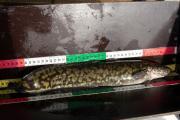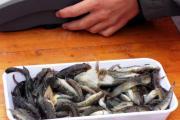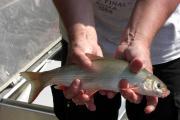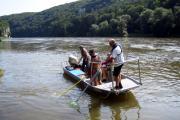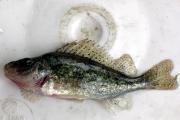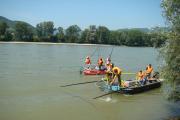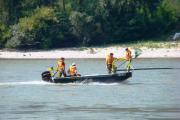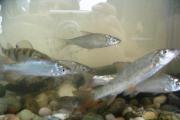
With early results in from the Upper Danube in Germany and Austria, the ‘JDS2 Fish Team' found plenty of species native to Danube waters such as bleak, chub, catfish, barbel, nase, perch, Balon's ruffe and Danube roach. Also recorded were ‘self-sustaining populations' of threatened species like Danube salmon and Streber - meaning that the fish are naturally reproducing in Danube river sections, different ages of the species can be found and their natural habitat remains intact for reproduction. That's good news. However, the Team also found plenty of significant deviations including ‘invaders' such as eel, round goby and pumpkinseed, all in abundance.
Rip-rap homes for eel and goby
At Station 5 at Niederalteich, Germany, eel (Anguilla Anguilla) was the second-most frequent species spotted according to relative abundance. "Eel occur frequently in this kind of ‘rip-rap' habitat, an artificial habitat that we have observed at many sampling stations," says Austrian biologist Christian Wiesner. Rip-rap is basically large boulders that have been artificially placed to fix riverbanks, especially at channelized and impounded river sections. "Eel continue to be stocked by fishing associations for commercial fishing, for example upstream from Jochenstein, Germany (Station 7), even though this is forbidden in Germany and Austria," says Austrian fish expert Nikolaus Schotzko. "A good water management tool would be to replace the rip-rap with natural habitat such as gravel bars where young fish like nase and barbel could reside again."
Over the last 10 to 15 years, the population of round goby (Neogobius melanostomus) has also skyrocketed along the German and Austrian stretches of the Danube, having made an appearance downstream in Slovakia only a few years ago. A non-native Danube species, goby eggs were accidentally transported in the ballast of ships from the goby's home in the Black Sea. Goby also reside and multiply in rip-rap, and threaten local fish species by eating young fish and eggs. However, higher populations of burbot (Lota lota), the world's only freshwater cod species, appear to be reducing the abundance of the goby invader. "Burbot, a native Danube species, also live in rip-rap and eat goby."
Team and technique
The JDS2 is the first time ever when fish will be assessed along the entire Danube. The Fish Team consists of five persons headed by Austria's Christian Wiesner. Schotzko and Slovakia's Jaroslav Cerny have the shift from Regensburg, Germany to Osijek, Croatia, then replaced by Hungary's Gabor Guti and Romania's Grigore Davideanu for the rest of the survey. National Fish Teams have also been very active, either sampling their own sites or working with the JDS2 Team.
The Team uses electro-fishing, either hand-held or from the boom of their ship, to sample fish from banks and shallow areas. After about 1.5 to 2 meters depth, driftnets are needed. The fish are then counted, measured, assessed and returned to the waters. In total, 40 sites will be sampled over the survey - each site sampled during the day and evening. At 25 sites, tissue samples from bream fish will be taken, to be analysed for organic substances and pesticides in laboratories. The team's ship, and sleeping quarters, is the Piscius, donated by the European Commission's Joint Research Centre.
Small is beautiful
Interestingly, at Station 8 (Abwinden Asten), the Fish Team caught high abundances of small nase (Chondrostoma nasus) and ide (Leuciscus idus) at the small ‘Murauer' side-arm. "This documents the importance of shallow side-arms with moderate through-flow conditions," says Schotzko. "They are crucial for the successful reproduction of typical Danube rheophilic (i.e. requiring currents) fish species and threatened Danube perch species like Streber, serving as safe habitat for the young and giving shelter from the waves of cruising vessels." Also at Station 8, during the night, the Austrian National Team caught a large catfish (Silurus glanis), over one meter long, in the main channel, before returning it unharmed, after measurement, to its home waters.












